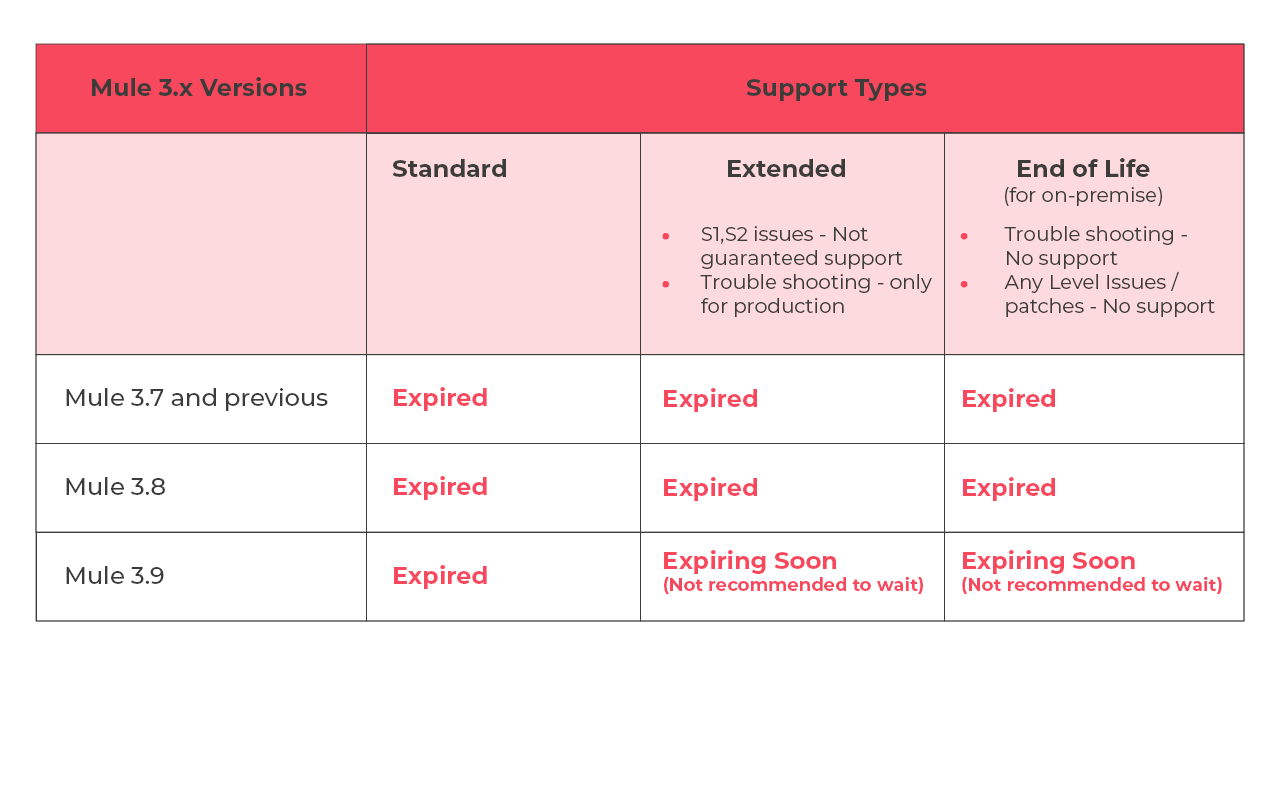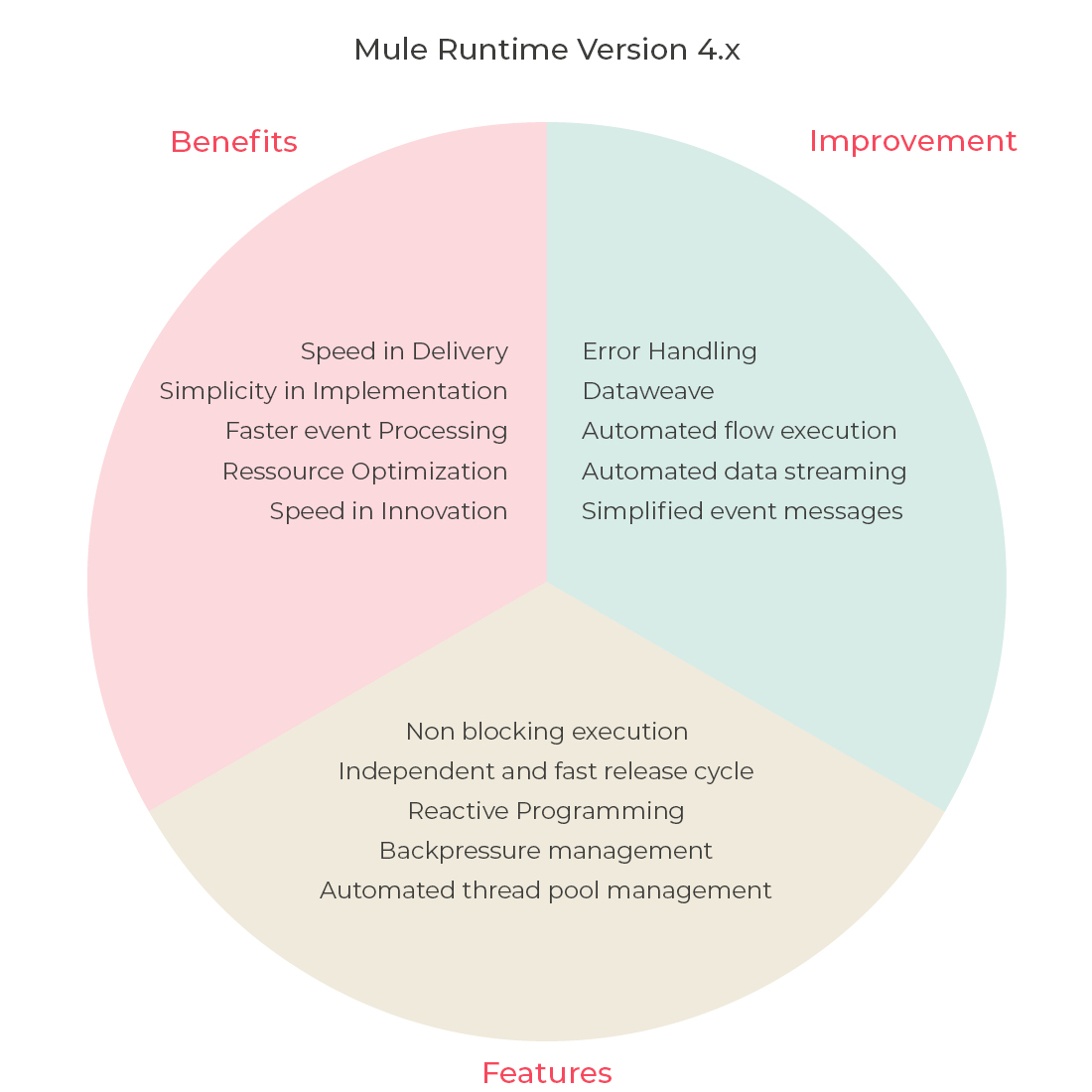Which release should you be on?
MuleSoft released Mule Engine Version 4 back in March 2018. The benefits of the Mule engine version 4 are considerable – including a simplified language for connectivity, clear access to data, automatic tuning, and a smoother upgrade process. Top of the list of benefits is that Mule V4 can enhance application development velocity, while reducing the number of steps and concepts to learn by 50%.
The previous version was MuleSoft Engine Version 3.9 and the standard support for this version ceased in March this year. This means that should any issues or custom changes impact artefacts that are in production, support is not guaranteed by MuleSoft – putting all the artefacts still running in V3 at risk. Risk to artefacts in production = risk to your business!!
Migrations can take many months, so even though the final support may not run out until March 2024, the reality is that if you haven’t yet started to migrate, there is already a race against the clock to start before the risk of having production systems running in an unsupported environment is very very real.
With the end of support deadline in mind, I took a closer look at the benefits of Mule Engine V4 and offer rationale for your business case to start migration to V4 right now!
The chart shows the Mule versions and the support types and end dates. Once support expires for V3.9 production systems are at risk.

Deliver new features – faster
MuleSoft has simplified the various implementations for V4. A redesigned programming paradigm, simplified connectors, and the automation of processing of threads are the main beneficiaries of simplification among a long list!
The programming model is standard and well established in the industry, so it’s easier to start working on Mule 4, making it possible to deliver critical business functionality – faster.
Mule 4 engine’s reactive design with asynchronous and non-blocking programming paradigm improves the overall efficiency of the solution developed using Mule 4.
Optimise your resource utilisation with automated thread pool management
Mule 4 features automated thread pool management. Threads are dynamically assigned to the application to maximise concurrency and allow event processors to execute in a way that optimises resource utilisation.
Memory and disks are utilised in a way that facilitates stream processing of larger than memory payloads. Backpressure management is another key feature in Mule 4. It is automatically managed by the runtime, allowing it to auto-tune the processing of massive amounts of data.

Faster event processing
Mule 4 allows faster event processing with easy to implement, simplified features including; seamless access to data using dataweave, design time error handling with new error handlers, automated data streaming, automated flow execution with support of triggers to various connectors to start flow processing, and simplified event messages, among many more.
Fuel innovation with the independent and fast release cycle of runtime and connectors
The independent and fast release cycle of Mule runtime and connectors means application developers can innovate faster and independently. To take advantage of the new features of connectors, all that’s needed is to upgrade the connector version with no need to wait for the mule engine version upgrade. The same logic works the other way around.
Increase speed and Scale through reactive programing and non-blocking execution
Mule 4 is built to satisfy speed and scale needs. The runtime engine adopts a reactive programming model to facilitate non-blocking execution of common domains in integration development such as connectivity, transformation, validation, error handling, and security. Mule 4’s ability to facilitate non-blocking execution of the event processors allows it to easily scale the amount of events it can handle concurrently.
Take risk off the table and choose the speed, efficiency and innovation of Mule V4
As businesses continue to recover from the last 18 months, repositioning and reenergizing themselves for 2022, beating the competition to innovate and get new features out there fast will be key.
Looking to make the move to V4 now will not only mitigate unnecessary business risks but will no doubt put your organisation a step ahead in the years to come. As your competitors try to catch up and struggle with breakages and events that no longer have MuleSoft support, your teams will be focussed on maximising the benefits of simplification and speed Mule V4 version brings.
Not sure where to start?
Our MuleSoft team is ready to help! If you need to move forward with your migration, get in touch and we can take you through our approach to migration strategy and make sure you reap all the benefits of Mule V4 in 2022. Contact us here.